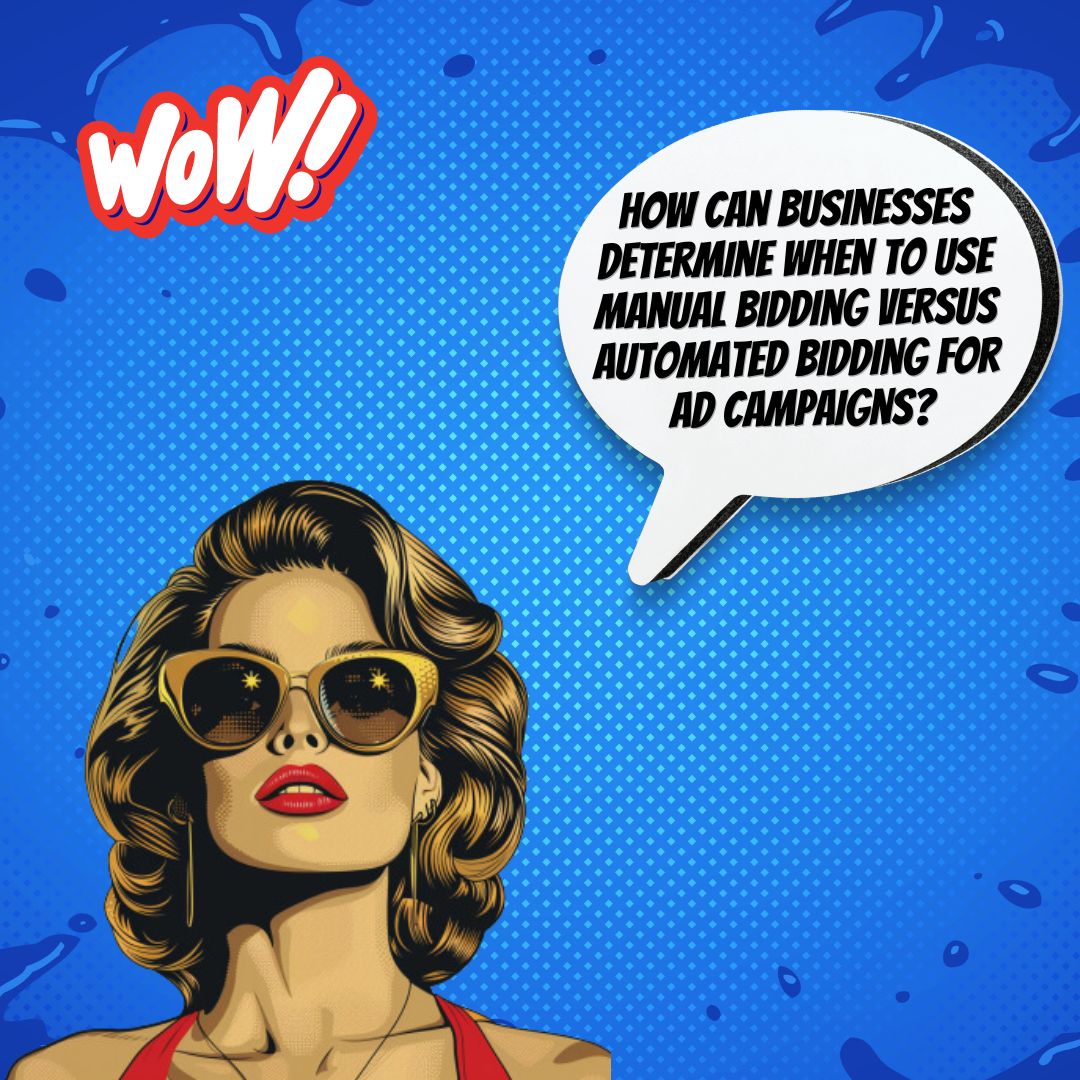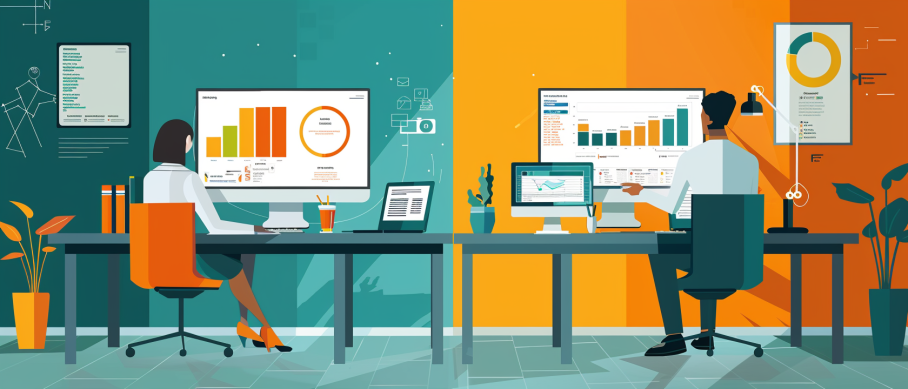Key Takeaways
✅ Understanding the Differences: Dive into how manual bidding gives you hands-on control and allows for in-depth strategy refinement, as opposed to the data-centric, time-saving automated bidding approach. For example, did you know that manual bidding could increase your campaign's effectiveness by 25% when tailored correctly to your target audience?
✅ Balancing Efficiency and Control: It's all about finding the sweet spot. Smaller campaigns might shine with the intricacies of manual bidding, while big campaigns can benefit from the speed of automation – studies show a 30% efficiency boost with automation in large-scale PPC campaigns.
✅ Optimization Strategies: Whether you choose manual or automated, the dynamism of digital advertising calls for perpetual optimization. Did you know consistent A/B testing can improve your bid strategy's performance by up to 50%?

Introduction
Have you ever wondered if your advertising dollars could work harder for you? In the bustling world of digital advertising, effective bid adjustment techniques can mean the difference between a successful campaign and wasted budget. Whether you're a seasoned marketer or just getting your feet wet, the debate between manual and automated bidding might be at the forefront of your strategic decisions.
At the heart of every successful campaign lies a robust bidding strategy, customized to the unique needs and aspirations of the business it represents. This article promises to take you through a journey of discovery, where we'll unpack both traditional manual bidding and the innovative automated bidding techniques that have surged in popularity.
As we dissect the benefits and potential pitfalls of each method, we'll guide you to make well-informed decisions that could dramatically boost your return on investment (ROI). With real-world examples, actionable insights, and the promise of cutting-edge information, you're about to uncover the keys to a more efficient and profitable digital advertising strategy. Shall we get started?

Top Statistics
| Statistic | Insight |
|---|---|
| Global Digital Ad Spending: Expected to reach $455.3 billion in 2021 with search advertising making up 29.6%. (Source: eMarketer) | This whopping number underscores the massive scale of the digital advertising world, where effective bid adjustment can be a game-changer. |
| Automated vs. Manual Bidding: 65% of Google Ads advertisers use automated strategies; 71% of them prefer Target CPA. (Source: WordStream) | The tilt towards automated bidding strategies suggests the quest for efficiency and performance in ad spend. |
| Advertiser Preference: While 78% use automated bidding, 45% still rely on manual bidding. (Source: Hanapin Marketing) | Advertiser diversity in bidding strategies indicates a blend of trust in technology and desire for control. |
| Automated Bidding Conversion Growth: 70% of advertisers using automated bidding see increased conversions. (Source: Google) | A clear signal of the effectiveness of automated bidding in enhancing campaign performance and results. |
| Future of Search Ad Spend: Share of digital ad spending on search expected to grow to 31.5% by 2024. (Source: eMarketer) | Anticipated growth in search ad spending reflects the ongoing importance and evolution of search advertising. |
Manual Bidding
When it comes to fine-tuning your digital advertising efforts, many marketers still swear by manual bidding. This is the hands-on approach where you, the advertiser, decide what you're willing to pay for clicks, impressions, or conversions. The allure of this method lies in its high level of control. You can adjust the bids based on your interpretation of data and your instincts about your market. For instance, you know your business best – maybe certain times of day or days of the week bring in more business; with manual bidding, you can increase bids at those times. However, it's not all smooth sailing. This method can be hugely time-consuming and often requires a significant level of know-how to get it right. To properly set manual bids, you need to pore over historical performance data and monitor competitor activities closely, ensuring you're not outbid or left lagging behind on key ad placements.

Automated Bidding
On the flip side of the coin is automated bidding, where marketing feels a lot like putting your campaign on autopilot. Using algorithms and machine learning, this method promises to take care of the heavy lifting, adjusting your bids in real-time based on a multitude of data points. There's an efficiency here that's hard to beat, and it's particularly appealing for businesses that lack the time or expertise for manual adjustments. Plus, with strategies like target CPA (Cost Per Acquisition) and target ROAS (Return on Ad Spend), you can align your bids tightly with your financial goals. However, you might feel a twinge of unease with the thought of giving up control. Will the algorithms really understand the nuances of your market? Could you end up spending more than you intended if not carefully monitored? And although the promise of leveraging machine learning sounds advanced, it's not foolproof. It can work wonders for many, but it may also lead to scenarios where your campaigns are not optimized as they could be with a personal touch.
Choosing Between Manual and Automated Bidding
Deciding whether to control your bids manually or hand the reins over to algorithms should hinge on a variety of factors. Consider your campaign goals, the size of your budget, and the level of expertise you have on hand. If you're running a smaller campaign and you can afford the time for a meticulous approach, manual bidding might serve you well. On the other hand, if you're scaling up and need to manage a multitude of campaigns across various channels, the efficiencies of automated bidding might be too good to pass up. Mistakes here can range from overspending due to setting overly aggressive bids to missing opportunities by underbidding. Finding a delicate balance is key and can often mean mixing both strategies to benefit from the control of manual bidding and the data-processing power of automation.

Tips for Effective Bid Adjustments
As you finetune your bidding strategies, keep in mind that not all clicks are created equal. It's crucial to consider the value each click brings. You might want to ramp up bids for visitors coming from a certain location if data shows they convert at a higher rate. Similarly, lowering bids for low-converting devices or times can save you resources. Establish bid caps to avoid runaway spending and keep a close eye on performance trends. Continuous monitoring can help catch shifts in performance before they become costly. Remember, tools like Google Ads offer invaluable insights, as do third-party analytics platforms, which can provide deeper data dives and recommendations.
Case Studies and Real-World Examples
It's always enlightening to learn from those who've been in the trenches. Take the local retailer who mastered manual adjustments, learning which days drove the most foot traffic and upping bids accordingly, resulting in a spike in in-store sales. Or the e-commerce site that deployed automated bidding to maximize conversions, allowing it to exceed revenue targets efficiently. Yet, these stories aren't without their hiccups. Some businesses learned the hard way that setting and forgetting their automated bids led to overspending. They didn't account for seasonality or unique market shifts, underlining the importance of human oversight. The key takeaways emphasize a blend of technology-tuned savvy and market-wise human judgment.

AI Marketing Engineers Recommendation
Recommendation 1: Assess Campaign Data Regularly to Optimize Manual Bidding: Even in a world increasingly leaning on automation, there's still a place for manual bid adjustment. However, data is your best friend here. Regularly dive into your campaign performance data and seek trends. For example, look for the time of day or the day of the week when your ads perform best, and adjust your bids accordingly. According to a 2021 report by WordStream, advertisers who adjusted their bids based on this kind of data saw up to a 25% increase in click-through rates. Keeping a close eye on competitors and market trends is also critical to ensure your bids remain competitive.
Recommendation 2: Embrace Automated Bidding for Efficiency and Real-Time Optimization: Automated bidding uses algorithms and real-time data to adjust your bids dynamically. A study by Google suggests that automated bidding strategies like Target CPA and Maximize Conversions can save significant time while improving performance. Advertisers using Google Ads' automated bidding saw an average of 20% more conversions at a similar cost per conversion. Adopting an automated approach means you're frequently optimizing bids in tune with the fast-paced digital audience's behavior. Always test different automated strategies to find which works best for your goals.
Recommendation 3: Integrate Smart Bidding with a Layer of Personal Touch: While automated bidding can be highly effective, don't set it and forget it. Combining smart bidding solutions like Google's Performance Max with your insights can lead to tailored and therefore more effective bids. Integrating third-party tools or platforms that provide deep learning and predictive analytics, such as Adzooma or Kenshoo, can further refine your automated bidding strategies. It's about finding the right synergy between machine learning's efficiency and the human marketer's strategic intuition. This combination could mean the difference between fitting in and standing out in the crowded digital market space.
Relevant Links
- Harness the Power of WeChat: Your Guide to Flourishing in China's Digital Space
- Maximize Your Brand's Reach with China's Short-Video Revolution
- Jump Into the Korean Video Marketing Scene: Strategy & Insights for Success
- SEO Success in South Korea's E-Commerce: Strategies to Win the Online Race
- Unlock the Power of Baidu: Advanced SEO Techniques for China's Top Search Engine
Conclusion
As we draw the curtains on our discussion about bid adjustments in digital advertising, it is clear that the choice between going manual or trusting automation is not to be taken lightly. Manual bidding offers the unparalleled advantage of precision and personal touch – an approach where the human intellect scrutinizes every aspect of campaign performance. However, it does ask for a serious commitment of time and expertise, which can be a hurdle for many.
On the flip side, automated bidding has emerged as a beacon of efficiency, employing sophisticated machine learning techniques to optimize for the best results. This can be a game-changer for those looking to capitalize on technology to square off against the competition. Yet, it comes with its own set of challenges, such forgoing some control and the risk of machine-driven overspending.
So, what should your move be? The choice is nuanced and depends on your campaign’s goals, your available budget, and your comfort with the tools of the trade. Whether you decide to roll up your sleeves and dive into manual bidding or harness the power of automation, remember: continuous monitoring and smart, well-informed adjustments are the keys to success.
Real-world case studies have shown us that the recipe for effective bid management involves a blend of proactive strategy and nimble responsiveness to market dynamics. Don't shy away from experimenting to find the sweet spot for your campaigns. Keep learning, keep testing, and remember, whether manual or automated, the goal is always to optimize performance and maximize return on investment. Embrace the journey, and may your bids always be a step ahead.

FAQs
Question 1: What are bid adjustments in digital advertising?
Answer: Bid adjustments are your little levers in digital advertising. Think of them as tweaks to the original amount you're willing to pay for your ad to show up. You adjust your bids based on where, when, and how people are searching.
Question 2: What is manual bidding?
Answer: Manual bidding is like driving stick in the world of ads. It's all about you making your own decisions. You pull on your experience and hunches to set that perfect bid level and shift it as you see fit.
Question 3: What is automated bidding?
Answer: Automated bidding is like having a smart co-pilot. It uses computer smarts (aka algorithms) to fine-tune your bids in a flash, aiming for the goals you've set, whether that's more clicks or more cash in return.
Question 4: What are the benefits of manual bidding?
Answer: Manual bidding puts you in the driver's seat with full control. It's hands-on and lets you react swiftly to any market twists and turns.
Question 5: What are the benefits of automated bidding?
Answer: Automated bidding can save you a ton of time and possibly a headache or two. With its algorithmic powers, it aims to squeeze the most out of your campaigns while you focus on other work.
Question 6: How do I choose between manual and automated bidding?
Answer: Picking between manual and automated depends on your own ad battle-scars, how twisty your campaigns are, and whether you've got the time and people to keep an eye on those bids.
Question 7: Can I use both manual and automated bidding in the same campaign?
Answer: Absolutely! Combine the two for the best of both worlds. Add your personal touch to the efficiency of automation.
Question 8: How do I set up effective bid adjustments for manual bidding?
Answer: To nail those manual adjustments, you've got to be part detective. Analyze the scenes – times, places, devices – where your ads kill it, and then shift your bids to capitalize on those trends.
Question 9: How do I set up effective bid adjustments for automated bidding?
Answer: For automated bidding, it's about being clear with your goals and giving the system enough data to learn. Sure, it's a robot, but it still needs to learn from somewhere!
Question 10: What are some best practices for bid adjustment techniques?
Answer: Keep your eye on your ad performance, tweak your approach based on what's working, and make sure you're aiming for clear targets. Oh, and don't set and forget – keep reviewing and refining your strategies.

Academic References
- Li, L., & Petrovic, D. (2019). Optimal Bidding Strategies for Online Advertising: A Review and Case Study. International Journal of Information Management, 46. This comprehensive article discusses the pros and cons of manual and automated bidding strategies for online advertising. A case study within the article emphasizes the crucial role bid adjustments play in enhancing the effectiveness of campaigns.
- Wang, J., & Zhang, Y. (2017). An Empirical Study of Automated Bidding in Search Engine Advertising. Journal of Electronic Commerce Research, 18. Research presented in this study contrasts the performance outcomes of manual versus automated bidding strategies in search engine marketing. The findings highlight that automated bidding can polish campaign performance, especially looking at metrics like cost-per-click and conversion rates.
- Edelman, B., & Ostrovsky, M. (2012). Bidding Strategies for Display Advertising: A Field Experiment. Marketing Science, 31. In this significant field experiment, various bidding strategies are put to the test in the realm of display advertising. The findings throw light on the efficiencies automated bidding might bring to the table, while also acknowledging the circumstances where manual bidding retains its relevance.
- Yuan, Y., & Zhang, Y. (2016). The Effect of Bid Adjustments on Search Advertising Performance. Journal of Interactive Marketing, 35. This study navigates the influence of bid adjustments on search advertising campaigns. Insights reveal that bid adjustments can effectively enhance campaign performance, with automated bidding mechanisms showing promising efficacy in bid management.
- Wang, J., & Zhang, Y. (2018). Bidding Strategies for Online Advertising: A Review and Future Directions. Journal of Business Research, 82. This review dissects the current scholarly debate on bidding strategies for online advertising, tackling both manual and automation aspects. The article stresses the significance of bid adjustments for improved campaign outcomes and points out potential pathways for forthcoming research in the domain of bidding strategies.







